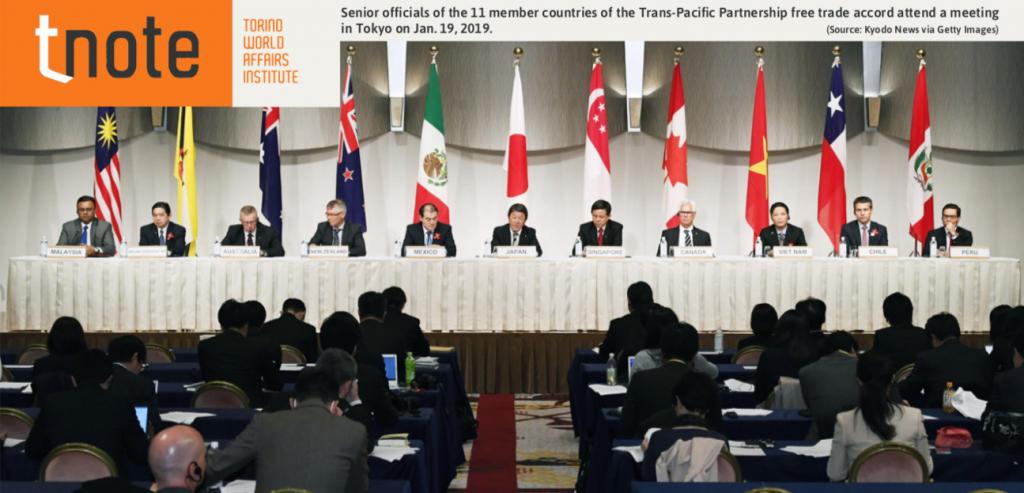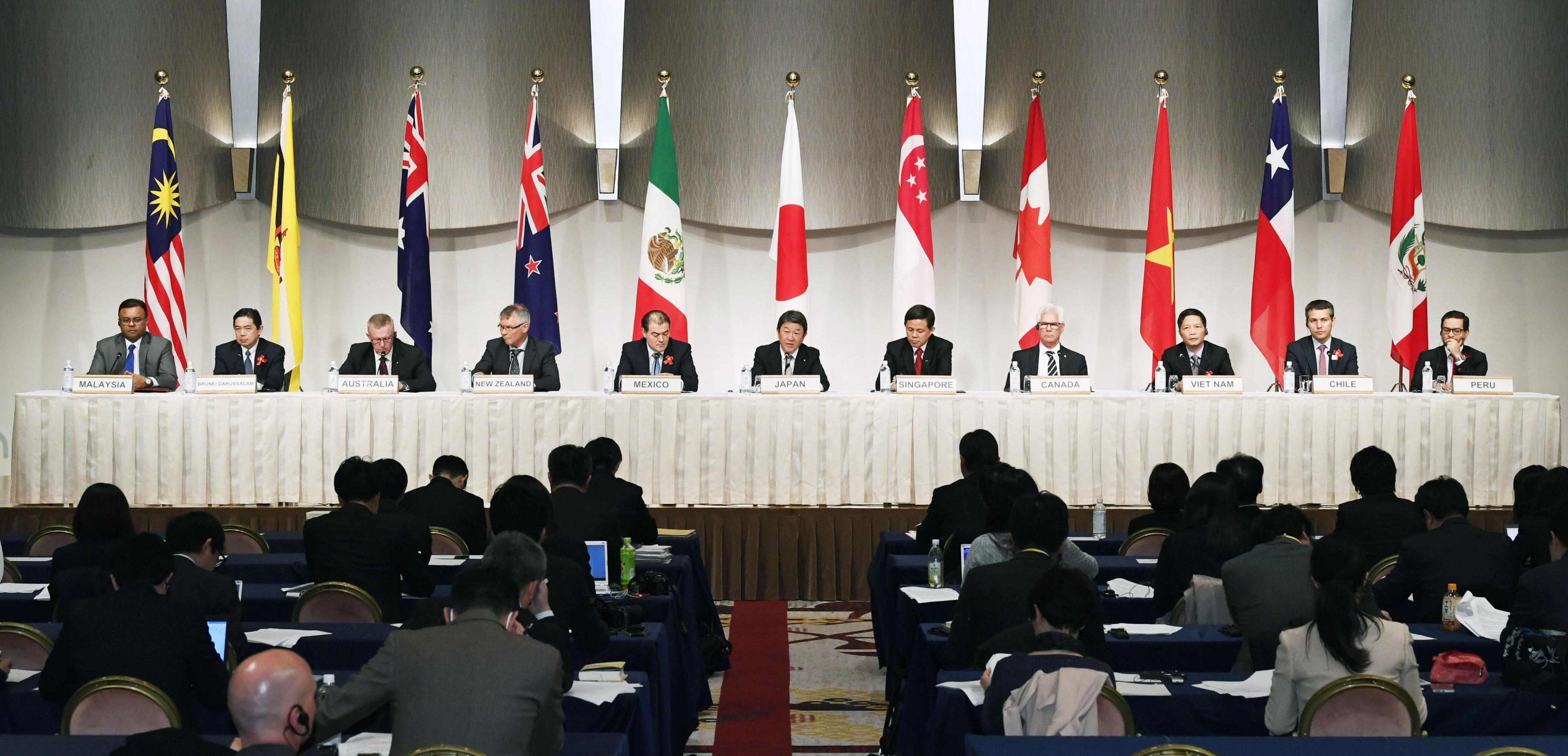
Mega-regional trade agreements are vehicles for geoeconomic clauses and geopolitical logics. This can be observed in mercantile agreements such as the Trans-Pacific Partnership (TPP), signed on 4 February 2016; its most recent version, the Comprehensive and Progressive Agreement for Trans-Pacific Partnership (CPTPP), signed on 23 January 2018; and the Regional Comprehensive Economic Partnership (RCEP), the final signing of which was expected during the ASEAN summit in November 2018 but has been postponed to 2019.
Originally, the TPP was a regional trade agreement between 12 participating states (Australia, Brunei, Canada, Chile, Japan, Malaysia, Mexico, New Zealand, Peru, Singapore, Vietnam and the United States) that aimed to eliminate tariff and non-tariff barriers to trade.
Key measures were the liberalization of the Internet, the establishment of international arbitration for disputes between states and private companies, and the elimination of obstacles to trade in agricultural goods, textiles, clothing and footwear.
Led by the US, the agreement sought to enforce a pivotal principle of US grand strategy – that of Wilsonianism-cum-primacy, according to which global geoeconomic openness is parallelled by Washington’s, nationally-informed geopolitical dominance.
In this sense, the TPP represented a legal-institutional, normative framework. Its objective was the bypassing of slow multilateral mechanisms – such as the Doha Round of the World Trade Organization (WTO) – that are increasingly undermined by a systemic shift towards multipolarity. Liberalizations in strategic sectors such as intellectual property (IP) and information technology (IT) carried particular weight. The intention was to strengthen US-friendly multilateralism in the Asia-Pacific region while excluding China from a huge but non-confrontational economic-institutional arrangement. In fact, by sanctioning state-owned companies, the TPP imposed free-market discipline on Chinese state capitalism, the source of Beijing’s geopolitical power. Together with the Bilateral Investment Treaty (BIT) – a US–China agreement still on the table but stalled by current trade tensions – the goal of the TPP was to stimulate domestic reforms and bring Chinese companies into the field of free, open competition, where some strategic US industries thrive, such as technology, pharmaceutical and soy.
Trump withdrew the US from the TPP with an executive order on 24 January 2017. On the one hand, this move was necessary for the populist president to deliver on his anti-globalist electoral agenda. On the other hand, this was the prelude to the current tensions between the US and China on trade sanctions.

Senior officials of the 11 member countries of the Trans-Pacific Partnership free trade accord attend a meeting in Tokyo on Jan. 19, 2019. Source: Kyodo News via Getty Images
However, it would be inaccurate to consider the TPP with 11 members (TPP 11) to be qualitatively different from the TPP 12. Although the US has left the agreement, the new TPP continues to cover a large commercial area and provide a normative framework based on the blueprint of the TPP 12. The remaining nations’ economies represent 13%–15% of global GDP – a total of $10–13 trillion dollars – and include up to 495 million people. With this agreement, 98% of the trade barriers among the 11 members will disappear.
The conflation of geoeconomic and strategic benefits that framed the TPP 12 still remains to the advantage of other members. The exclusion of China continues to protect technologically-driven Japan, Singapore and Australia from Beijing’s state-owned, competitive companies. Moreover, the departure of the US favours Japan as a technological hub.
Regardless of China’s competitive power, the TPP 11 also benefits Vietnam, which will be the most dynamic and lowest-cost fabric and apparel manufacturer within the partnership. In addition, it will allow Australian agricultural products to be exported in greater quantities and with greater profits, although the extent to which TPP 11 will benefit Australia is contested. Over the next decade, industrial property markets, particularly in Canada and Japan, could gain from the “higher demand for services that are exported or utilised for trade”.
While the absence of the US might favour some high-tech sectors of the Japanese economy, this is bad news for service economies like Singapore and exporters such as Vietnam and Malaysia – given the size of the American market. These countries, however, will still reap lavish benefits. Singapore will perform well, thanks to its strategic port, as a regional finance and services hub. Vietnam and Malaysia will increase their production and textile exports. According to the Peterson Institute for International Economics, the TPP 11 will add 2% to growth in some countries, such as Malaysia, Singapore, Brunei and Vietnam, while New Zealand, Japan, Canada, Mexico, Chile and Australia will grow at a faster pace than before the agreement was signed. The TPP 11, however, will be slightly slimmer than the TPP 12. The government of New Zealand reported that as many as 22 provisions were suspended by the new agreement and are currently awaiting further rule-specific negotiations. These suspensions affect, among other rules, the investor–state dispute settlement (ISDS) mechanism and patent copyright. Regarding the settlement of disputes, multinational corporations will be unable to sue governments at international judicial bodies over disputes relating to the ‘public interest’. As for copyright, it will not be raised from 50 to 70 years – originally, this extension was a protectionist measure strongly desired by the US pharmaceutical industry.
Although these are important changes, one should not overreact to the US’s withdrawal. In fact, there are domestic pressures within the US itself to rejoin: from Republican senators, and farmers, for instance. The TPP 11 “could become a blueprint for future regional free trade agreements” or for a return to a TPP 12. Certainly, the US could lose 0.5% in GDP growth, in addition to $2 billion, if companies based in member states of the TPP 11 decide that it is more convenient to trade with one another. However, the TPP 11 still benefits Washington. Firstly, the US could always rejoin, either with or after Trump: the US Treasury Secretary Steven Mnuchin – and the president himself – hinted at the possibility that the US might come back. If this is to happen, however, the US will need to accept current provisions. Secondly, the TPP 11 continues to serve as an obstacle to China’s geoeconomic and geopolitical hegemony.
Meanwhile, as Trump has backtracked from the international liberal order, China could lead regional integration through the RCEP. Many observers do not consider the TPP and the RCEP to be competing agreements. The RCEP stems from ASEAN’s agenda for deepening regional integration. It is an agreement between ASEAN’s members – Brunei, Cambodia, Indonesia, Laos, Malaysia, Myanmar, the Philippines, Singapore, Thailand and Vietnam – and their Asia-Pacific trade partners – Australia, China, India, Japan, South Korea and New Zealand.
This integration is of particular importance to those states that risk ‘economic marginalization’. However, given the exclusion of the US from this agreement, there is concern about China’s hegemonic role. The RCEP is strongly endorsed by Beijing as its legal provisions on state-owned enterprises, labour and environmental standards are not as ambitious and strict as those of the TPP.
This divergence leaves a question unanswered: whether the TPP raises RCEP’s future standards will depend on the success and international image of China’s capitalism, and on Washington’s regional influence.
Download

Copyright © 2024. Torino World Affairs Institute All rights reserved
